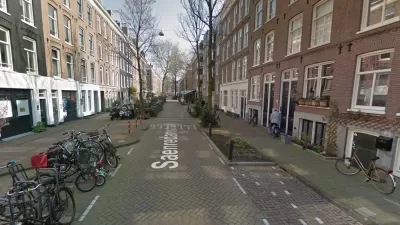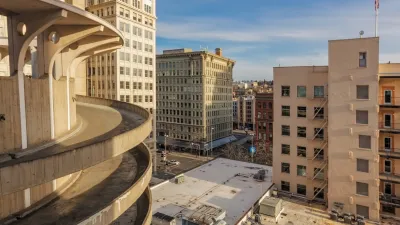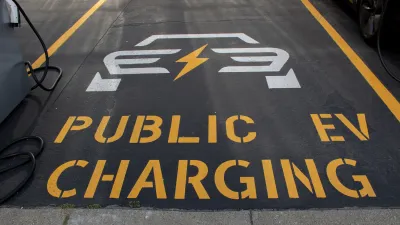New research out of the University of Connecticut shows that making room for parking in cities only leads to more cars, and less people and economic development.
Building on research from the University of Pennsylvania that validated the idea that more space for cars in dense cities translates to less space for people, Chris McCahill and Norman Garrick "found that cities with higher rates of driving have fewer people – a difference of more than 4,000 people per square mile for each 10 percent change in automobile use," in work published recently in Urban Design International.
The authors look at the histories of six cities that bolstered their parking beginning in the 1960s to "support economic development and help their cities compete with the surrounding suburbs."
"If the function of parking in these places was to enable growth and development, the data suggests they were abysmal failures," note the authors. "The number of people and jobs dropped by as much as 15 percent and the median family incomes fell by 20 to 30 percent in some places. Today, these places still struggle to compete in their regions."
However, in the three cities that changed course in the 1980s to limit the provision of parking, the authors found a different outcome. "Even as they cut back on surface parking, the number of people and jobs climbed upward, as did incomes. Less parking in these places has meant the urban fabric can be stitched back together and there is more space for shops, restaurants, jobs and other things that make cities great."
FULL STORY: Cars and Robust Cities Are Fundamentally Incompatible

Trump Administration Could Effectively End Housing Voucher Program
Federal officials are eyeing major cuts to the Section 8 program that helps millions of low-income households pay rent.

Planetizen Federal Action Tracker
A weekly monitor of how Trump’s orders and actions are impacting planners and planning in America.

Ken Jennings Launches Transit Web Series
The Jeopardy champ wants you to ride public transit.

Washington Legislature Passes Rent Increase Cap
A bill that caps rent increases at 7 percent plus inflation is headed to the governor’s desk.

From Planning to Action: How LA County Is Rethinking Climate Resilience
Chief Sustainability Officer Rita Kampalath outlines the County’s shift from planning to implementation in its climate resilience efforts, emphasizing cross-departmental coordination, updated recovery strategies, and the need for flexible funding.

New Mexico Aging Department Commits to Helping Seniors Age ‘In Place’ and ‘Autonomously’ in New Draft Plan
As New Mexico’s population of seniors continues to grow, the state’s aging department is proposing expanded initiatives to help seniors maintain their autonomy while also supporting family caregivers.
Urban Design for Planners 1: Software Tools
This six-course series explores essential urban design concepts using open source software and equips planners with the tools they need to participate fully in the urban design process.
Planning for Universal Design
Learn the tools for implementing Universal Design in planning regulations.
Heyer Gruel & Associates PA
Ada County Highway District
Institute for Housing and Urban Development Studies (IHS)
City of Grandview
Harvard GSD Executive Education
Toledo-Lucas County Plan Commissions
Salt Lake City
NYU Wagner Graduate School of Public Service





























